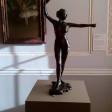Located in Somerset House, The Courtauld Institute of Art is amongst the most prestigious galleries in the world. Not only does it exhibit hundreds of well known paintings and artists, the gallery provides a visual timeline of the history of art, at least in Europe. Spanning from medieval art to paintings of the 20th century, The Courtauld reveals the gradually changing styles and techniques that influenced the old masters, and led to the contemporary artworks we create today.
Unless visiting with the intention of viewing a specific artwork, it makes sense to conduct your tour of the gallery in chronological order. Beginning on the ground floor, you can study and contemplate a collection of Medieval art and sculpture alongside a handful of paintings from the Renaissance era (13th-15th Century). Although spanning over two decades and being produced by different artists, many of the artworks look alike, not only in style, but content as well.
It does not take a genius to notice that everything displayed in Room 1 is of a religious (Christian) nature – the birth and death of Jesus Christ being the most predominant. This reveals a lot about the culture in Europe at that time, an era when religion was at the zenith of most people’s lives. As the information provided alongside the artworks explains, artists were often commissioned by the Church in order to deck out the building with religious effigies – either biblical, or depictions of saints.
Up the stairs, to the first floor, leads you to recognisable works from the 16th-19th centuries. Continuing with the Renaissance era, large paintings dominate the walls, again, mostly of religious scenes. This theme continues through to the 17th century with artists such as Rubens and the beginning of the Baroque era. However, it is from this point onwards that the artists’ choice of subject matter takes a dramatic change.
The 18th century brought about a shift in thinking in what is now referred to as the Enlightenment years. Scientific development of the past century was causing many to distance themselves from religion as they discovered the workings of the world for themselves, and worship inventors who were opening people’s minds to a future unlike any experienced before. As a result, presumably demand for biblical artwork dried up, causing artists to find other ways of attracting clientele.
Not only was the subject matter of art changing, but new methods of painting were being experimented with. The 19th century saw the beginning, middle and end of Impressionism, an art movement characterised by the usage of small, but visible, brushstrokes. Artists involved with this development, and exhibited at The Courtauld, include Monet, Manet, Renoir, Degas, and, of course, Vincent van Gogh.
The top floor of the institute brings you into the 20th century, the years in which a significant number of changes occurred in the art world. What you will notice are the contrasting techniques, choices of colour and differences in theme and imagery, particularly compared with everything you have viewed on the lower floors. Throughout Europe, artists were appropriating methods from their contemporaries and tutors while they sought their own, personal style. This is particularly noticeable when juxtaposing French paintings with German Expressionism, as well as a few British artists.
The experience The Courtauld provides differs significantly from the larger galleries in London – establishments where it is impossible to view everything in one visit. Rather than being a place to see a couple of well known paintings – although that is entirely possible should that be your intention – the gallery takes you on a journey: a trip through the history of art. Whether or not you decide to pay close attention to individual artworks, scanning the framed paintings on the wall gives you an instant sense of the dramatic changes the art world has encompassed throughout the last 700 or so years.
The Courtauld Institute of Art is worth the entrance fee to bare witness to the great artists of the past centuries, in what is a relatively peaceful environment. Whatever your expectations, it will be hard to be disappointed in your visit; the inclusion of a variety of art movements guarantees an interest for each individual. And, whilst the paintings are the main reason you are there, do not forget to look up and be impressed by the beautiful, awe-inspiring ceilings!






Pingback: Painter of Disquiet | Hazel Stainer